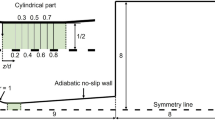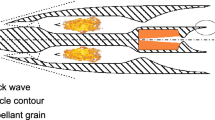Abstract
In this research, the fluid and thermal characteristics of a rectangular turbulent jet flow is studied numerically. The results of three-dimensional jet issued from a rectangular nozzle are presented. A numerical method employing control volume approach with collocated grid arrangement was employed. Velocity and pressure fields are coupled with SIMPLEC algorithm. The turbulent stresses are approximated using k–\({\varepsilon}\) model with two different inlet conditions. The velocity and temperature fields are presented and the rates of their decay at the jet centerline are noted. The velocity vectors of the main flow and the secondary flow are illustrated. Also, effect of aspect ratio on mixing in rectangular cross-section jets is considered. The aspect ratios that were considered for this work were 1:1 to 1:4. The results showed that the jet entrains more with smaller AR. Special attention has been drawn to the influence of the Reynolds number (based on hydraulic diameter) as well as the inflow conditions on the evolution of the rectangular jet. An influence on the jet evolution is found for smaller Re, but the jet is close to a converged state for higher Reynolds numbers. The inflow conditions have considerable influence on the jet characteristics.
Similar content being viewed by others
Abbreviations
- AR:
-
Nozzle aspect ratio (AR = L zi /L yi )
- c μ :
-
k–\({\varepsilon}\) Turbulence model constant
- c 1 :
-
k–\({\varepsilon}\) Turbulence model constant
- c 2 :
-
k–\({\varepsilon}\) Turbulence model constant
- D :
-
Equivalent circular jet diameter, m
- I :
-
Turbulence intensity
- k :
-
Mean turbulence kinetic energy per unit mass, m2 s−2
- L x :
-
Length of the computational domain in the x-direction, m
- L y :
-
Length of the computational domain in the y-direction, m
- L yi :
-
Half-length of the inlet vent in the y-direction, m
- L z :
-
Length of the computational domain in the z-direction, m
- L zi :
-
Half-length of the inlet vent in the y-direction, m
- M :
-
Momentum, kgms−2
- p :
-
Pressure, Pa
- P k :
-
Turbulence production due to viscous forces, kgm−1 s−3
- Pr :
-
Prandtl number
- Prt :
-
Turbulent Prandtl number
- Re :
-
Reynolds number based on hydraulic diameter
- T :
-
Temperature, K
- u :
-
Time-averaged velocity component in the x-direction, ms−1
- \({{u}^{\prime}_i}\) :
-
Velocity fluctuations in the x i directions, ms−1
- v :
-
Time-averaged velocity component in the y-direction, ms−1
- w :
-
Time-averaged velocity component in the z-direction, ms−1
- x :
-
Cartesian coordinate along the stream-wise length of domain, m
- y :
-
Cartesian coordinate along the span-wise length of domain, m
- y 1/2 :
-
Half-velocity width in the y-direction based on the u-velocity [u(y 1/2) = u cl/2], m
- yt 1/2 :
-
Half-temperature width in the y-direction [T(yt 1/2) = T cl/2], m
- z :
-
Cartesian coordinate along the lateral length of domain, m
- z 1/2 :
-
Half-velocity width in the z direction based on the u-velocity [u(z 1/2) = u cl/2], m
- α :
-
Thermal diffusivity, m2 s
- α t :
-
Turbulent thermal diffusivity, m2 s
- \({\delta_{ij}}\) :
-
Kronecker delta
- \({\varepsilon}\) :
-
Turbulent dissipation rate, m2 s−3
- μ :
-
Dynamic viscosity, Nsm−2
- μ t :
-
Eddy viscosity, Nsm−2
- ρ :
-
Density, kgm−3
- \({\sigma_k}\) :
-
Turbulence model constant for the k equation
- \({\sigma_\varepsilon }\) :
-
k–\({\varepsilon}\) Turbulence model constant
- cl:
-
At the jet centerline
- in:
-
At inlet plane of jet
- inf:
-
At ambient
- max:
-
Maximum
References
Turkus V.A.: Structure of the air inflow jet issuing from a rectangular hole. Zh. Otopl. Vent. 5, 11–19 (1933)
Trentacoste N., Sforza P.M.: Further experimental results for three-dimensional free jets. AIAA J. 5, 885–891 (1967)
Sforza P.M., Steiger M.H., Trentacoste N.: Studies on three-dimensional viscous jets. AIAA J. 4, 800–805 (1966)
Sforza P.M.: A quasi-axisymmetric approximation for turbulent three-dimensional jets and wakes. AIAA J. 7, 1380–1382 (1969)
Krashennikov S.Y., Rogalskaya E.G.: Propagation of jets from rectangular nozzles: free and those close to the screen Izv. Akhad. Nauk SSSR. Zhid. Gaza 4, 39–48 (1979)
Quinn W.R.: Turbulent free jet flows issuing from sharp-edged rectangular slots: the influence of slot aspect ratio. Exp. Thermal Fluid Sci. 5, 203–215 (1992)
Gutmark E.J., Grinstein F.F.: Flow control with noncircular jets. Annu. Rev. Fluid Mech. 31, 239–272 (1999)
Quinn, W.R., Pollard, A., Marsters, G.F.: On ‘saddle-backed’ velocity distributions in three-dimensional turbulent free jets. In: Proceedings of the AIAA 16th Fluid and Plasma Dynamics Conference, Danvers, MA, pp. 1677–1682 (1983)
Marsters G.F.: Spanwise velocity distributions in jets from rectangular slots. AIAA J. 19, 148–152 (1981)
Sforza P.M., Stasi W.: Heated three-dimensional turbulent jets. ASME J. Heat Transf. 101, 353–358 (1979)
Sfeir A.A.: The velocity and temperature fields of rectangular jets. Int. J. Heat Mass Transf. 19, 1289–1297 (1976)
Rajaratnam N.: Turbulent Jets. Elsevier, Amsterdam (1976)
Miller R.S., Madnia C.K., Givi P.: Numerical simulation of non-circular jets. Comput. Fluids 24, 1–25 (1995)
Wilson R.V., Demuren A.O.: Numerical simulation of turbulent jets with rectangular cross-section. ASME FED 238, 121–127 (1996)
Holdo A.E., Simpson B.A.F.: Simulation of high-aspect-ratio jets. Int. J. Numer. Methods Fluids 39, 343–359 (2002)
Rembold B., Adams N.A., Kleiser L.: Direct numerical simulation of a transitional rectangular jet. Int. J. Heat Fluid Flow 23, 547–553 (2002)
Launder B.E., Spalding D.B.: The numerical computation of turbulent flows. Comput. Methods Appl. Mech. Eng. 3, 269–289 (1974)
Rhie C.M., Chow W.L.: Numerical study of the turbulent flow past an airfoil with trailing edge separation. AIAA J. 21, 1525–1532 (1983)
Van Leer B.: Toward the ultimate conservative difference scheme. Monotonocity and conservation combined in a second order scheme. J. Comput. Phys. 14, 361–370 (1974)
Davidson, L., Farhanieh, B.: CALC-BFC: A finite-volume code employing collocated variable arrangement and cartesian velocity components for computation of fluid flow and heat transfer in complex three-dimensional geometries. Department of Thermo and Fluid Dynamics, Chalmers University of Technology, Rept. 91/14 (1991)
Zhou X., Sun Z., Brenner G., Durst F.: Combustion modeling of turbulent jet diffusion H2/air flame with detailed chemistry. Int. J. Heat Mass Transf. 43, 2075–2088 (2000)
Zhou X., Sun Z., Durst F., Brenner G.: Numerical simulation of turbulent jet flow and combustion. Comput. Math. Appl. 38, 179–191 (1999)
Malmström T.G., Kirkpatrick A.T., Christensen B., Knappmiller K.D.: Centreline velocity decay measurements in low-velocity axisymmetric jets. J. Fluid Mech. 346, 363–377 (1997)
Mi J., Nathan G.J., Luxton R.E.: Centreline mixing characteristics of jets from nine differently shaped nozzles. Exp. Fluids 28, 93–94 (2000)
Quinn W.R., Militzer J.: Experimental and numerical study of a turbulent free square jet. Phys. Fluids 31, 1017–1025 (1988)
Klein M., Sadiki A., Janicka J.: Investigation of the influence of the Reynolds number on a plane jet using direct numerical simulation. Int. J. Heat Fluid Flow 24, 785–794 (2003)
Quinn W.R.: Upstream nozzle shaping effects on near field flow in round turbulent free jets. Eur. J. Mech. B/Fluids 25, 279–301 (2006)
Deo R.C., Mi J., Nathan G.J.: The influence of nozzle-exit geometric profile on statistical properties of a turbulent plane jet. Exp. Thermal Fluid Sci. 32, 545–559 (2007)
Habli S., Mhiri H., Golli S.E., Palec G.L., Bournot P.: Numerical study of inflow conditions on an axisymmetric turbulent jet. Int. J. Thermal Sci. 40, 497–511 (2001)
Goldschmidt, V.W., Bradshaw, P.: Effect of nozzle exit turbulence on the spreading (or widening) rate of plane free jets. In: Joint Engineering, Fluid Engineering and Applied Mechanics Conference, ASME, vol. 1–7, Boulder, Colarado, June 22–24 (1981)
Berg J.R., Ormiston S.J., Soliman H.M.: Prediction of the flow structure in a turbulent rectangular free jet. Int. Commun. Heat Mass Transf. 33, 552–563 (2006)
Bejan A.: Convection Heat Transfer, 2nd edn. Wiley, New York (1948)
Zijnen B.G.: Measurement of the velocity distribution in a plane turbulent jet of air. Appl. Sci. Res. A 7, 256–276 (1958)
Behnia M., Parneix S., Durbin P.A.: Prediction of heat transfer in an axisymmetric turbulent jet impinging on a flat plate. Int. J. Heat Mass Transf. 41, 1845–1855 (1998)
Park T.H., Choi H.G., Yoo J.Y., Kim S.J.: Streamline upwind numerical simulation of two-dimensional confined impinging slot jets. Int. J. Heat Mass Transf. 46, 251–262 (2003)
Pope S.B.: Turbulent Flows. Cambridge University Press, Cambridge (2008)
Tsuchiya Y., Horikoshi C., Sato T.: On the spread of rectangular jets. Exp. Fluids 4, 197–204 (1986)
Author information
Authors and Affiliations
Corresponding author
Rights and permissions
About this article
Cite this article
Faghani, E., Maddahian, R., Faghani, P. et al. Numerical investigation of turbulent free jet flows issuing from rectangular nozzles: the influence of small aspect ratio. Arch Appl Mech 80, 727–745 (2010). https://doi.org/10.1007/s00419-009-0340-z
Received:
Accepted:
Published:
Issue Date:
DOI: https://doi.org/10.1007/s00419-009-0340-z




